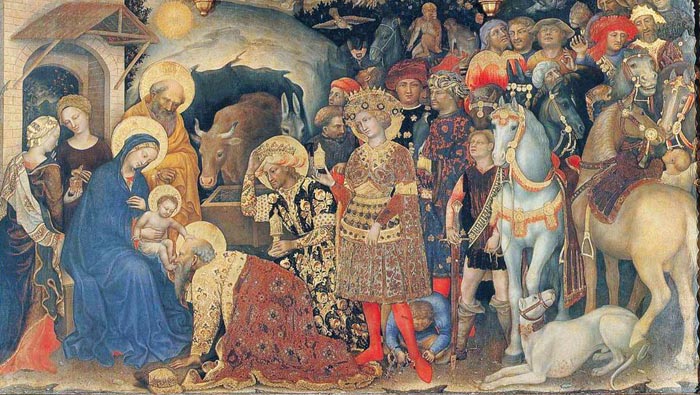 |
Gentile da Fabriano, Adoration of the Magi (detail), (1423) Tempera on wood, 300 x 282 cm Galleria degli Uffizi, Firenze |
| Gentile da Fabriano, Adoration of the Magi (1423) |
Gentile da Fabriano, or Gentile di Niccolò di Giovanni di Massio (c. 1370 – c. 1427) was born in or near Fabriano, near Ancona in the Marche. The most sought-after and famous artist in Italy during the first quarter of the 15th century, he carried out important commissions in several major Italian art centres and was recognized as one of the foremost artists of his day. Sadly, most of the work on which his great contemporary reputation was based has been destroyed, which may be why he is not more widely known today. |
|
| Giovanni di Paolo's The Presentation of Christ in the Temple formed a predella with a series of panels showing the Annunciation (National Gallery of Art, Washington), the Nativity (Pinacoteca Vaticana), the Crucifixion (Gemäldegalerie, Berlin), and the Adoration of the Magi (Cleveland Museum of Art). Three of these scenes adapt in a highly original fashion compositions deriving from Gentile da Fabriano's famous Adoration of the Magi altarpiece of 1423, painted for the Strozzi chapel in Santa Trinita, Florence (Galleria degli Uffizi, Florence). | ||
| Trained in Siena, Giovanni di Paolo was heir to a long tradition of famous painters who worked in the city. The artist borrowed heavily from his contemporaries in creating his own highly personal and graceful style. Giovanni di Paolo depicts the arrival of the Magi at Bethlehem in a wealth of color and detail befitting the riches they brought the Christ Child. The Magi pay homage to Christ as he sits on the Virgin's lap beneath a blazing, golden star. Crowns, sumptuous robes, a crowd of servants (one sprawling to remove the spurs of the standing king), and even a pet monkey stress the wealth and power of the visitors. The visit of the Magi is described in the Book of Matthew as the epiphany, when the arrival of Christ became known to the world. Magi are literally astrologers, but over the centuries, popular legends transformed them into kings and they are usually shown in royal robes and crowns. | ||
| St. Nicholas and the Three Gold Balls. From the predella of the Quaratesi triptych from San Niccolo, Florence. 1425. Tempera on wood. Pinacoteca Vaticana, Vatican, Rome. The scene illustrates the episode in which Nicholas saved three impoverished girls from prostitution by tossing three gold balls through their window one night. | Gentile da Fabriano, St. Nicholas and the Three Gold Balls. From the predella of the Quaratesi triptych from San Niccolo, Florence. 1425. Tempera on wood. Pinacoteca Vaticana, Vatican, Rome. | |
Quaratesi Altarpiece: Pilgrims at the Tomb of St Nicholas of Bari Gentile da Fabriano A Miracle of St. Nicholas. The last surviving work by Gentile da Fabriano documents, in this pilgrimage scene, an interesting chapter in the history of religion. It shows the viewer the pilgrimage to the tomb of St. Nicholas in Bari, the popularity of the pilgrimage site, and also, in the figure of the man front left, an instance of miraculous healing. |
Gentile da Fabriano. A Miracle of St. Nicholas. From the predella of the Quaratesi triptych from San Niccolo, Florence. 1425. Tempera on wood. The National Gallery of Art, Washington, DC, USA. |
 |
||||
Podere Santa Pia situated in panoramic position in the Maremma countryside
|
||||
Holiday accomodation in Tuscany | Podere Santa Pia | Artist and writer's residency
|
||||
Podere Santa Pia |
Podere Santa Pia, garden view, April |
View from Podere Santa Pia
on the coast and Corsica |
||
Additional literature |
||||
This page uses material from the Wikipedia article Gentile da Fabriano, published under the GNU Free Documentation License. |
||||



